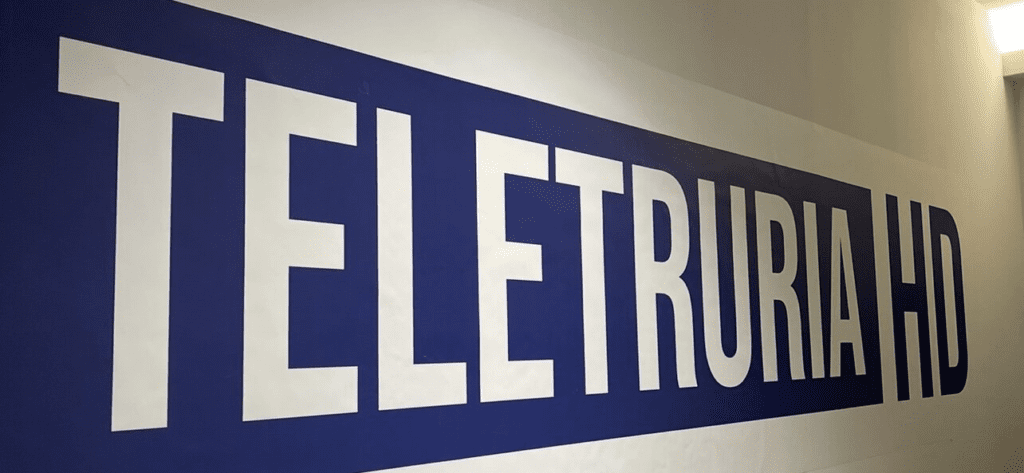
Teletruria Logo
On Monday March 10th, we–the Identifiers of Italian Innovators–went to Teletruria Studio, one of the main news outlets in Tuscany, especially in Arezzo. Located in Arezzo it serves to relay the news of today to the people through TV broadcasting, running 24-hours, seven days a week. When we arrived at Teletruria we were greeted with a very warm welcome and then promptly given a tour and quick history of Teletruria by Alex Revelli. After the tour, Alex Revelli and a broadcaster from Teletruria, Maddalena Pieroni, sat down with us for a more ‘formal’ interview. In this interview we discussed the importance of technology within media and more specifically what that looks like at Teletruria.
Teletruria is a great example of how technology is both a disruptor and an enabler in the shifting media landscape. Focusing on journalism, specifically media broadcasting, we are in a time in which the more innovations there is in technology the more innovation there is with journalism. This era where digital transformation dictates the trajectory of industries, media broadcasting has emerged as a prime example of innovation-driven change. With traditional television facing stiff competition from social media, online platforms, and changes in technology, Teletruria was faced with the necessity for adaptation.
One of the most significant innovations in modern broadcasting is the integration of traditional television with digital platforms. Teletruria has embraced this trend by expanding its content distribution to YouTube, Instagram, and other social media networks.
“The mainstream is the television. But it’s indispensable to broadcast the same news or other programs again in the social network, in YouTube, any other kind of, for example Instagram or other social network”
Furthermore, interactive engagement has become a cornerstone of modern broadcasting. By incorporating WhatsApp QR codes into live programs, Teleteria allows viewers to submit questions in real-time, fostering a dynamic and participatory media experience–we experienced this live in hand when we were interviewed on the show, and the audience submitted live questions through WhatsApp. This portion of our time at Teletruria was very special and truly encapsulates the spirit of the people at the company. It was so cool for them to invite us and have us live on Italian television.
“The future of television is this: the possibility to use multiple planes—social media, television, radio, YouTube, everything—but offering the opportunity to enter into my program and ask the question to my guest.”
Here we are live on set at Teletruria
However, these advancements come with challenges. With this emphasis on smartphones and social media, the consumption habits among younger audiences has significantly changed. Traditional TV viewership is declining, necessitating new strategies for media organizations to maintain relevance. Credibility, once easily established through well-known media brands, must now be continually reinforced in an era of widespread misinformation.
“Only 15 years ago, if you went on television, it was perfectly right. Everything the people saw on TV, they believed. Now, the young generation under 30 years old, they don’t use television, they use smartphones. The smartphone changed everything.”
Advancements in technology have significantly reduced the cost of professional broadcasting equipment. Where high-quality video cameras once, may have cost upwards of $100,000, comparable tools are now available for as little as $4,000. This ease in accessibility of technology means that success in media broadcasting is no longer determined solely by equipment but also by the skill and adaptability of journalists and production teams.
“Now it’s possible to have the video camera that we have in the studio cost €2,000. It’s very important to understand that it’s not the equipment; it’s the people. Because if you have the journalist with the capacity, it’s possible to fly. If you have a technical group with the capacity, it’s possible to fly. Without the person, it’s only a technical equipment.”
I love this quote, it shows the value in people, real people who make the difference in places like Teletruria. Honest hardworking places whose people are what make it great.
Teleteria has also found success by leveraging technology to deepen its connection with local communities. Daily street interviews, or ‘vox populi,’ help capture public opinion on current events, reinforcing the broadcaster’s role as a community touchpoint.
“It happens every day because every day you have a piece of news. After you have a piece of news, the second thing you do is go among people and ask them what they think about it. Without people’s opinion, it’s useless. You can’t get into a community.”
This technology of going out, among the people, hearing their voice, is what I found to be most interesting. Teletruria’s importance on this voice and emphasis on the people of Arezzo is essential in the heart of the company and what has made it successful.
Overall, the media landscape is undergoing rapid transformation, driven by technological advancements and shifting audience behaviors. Teletruria’s evolution emphasises the necessity for adaptability.
“Now, YouTube videos are producing 50% more views than traditional television. Everything is changing.”
Ultimately, the future of broadcasting lies not in resisting change but in leveraging technology to build more inclusive, accessible, and engaging media experiences. As digital platforms continue to shape content distribution, Teletruria understands that it must embrace this innovation, harness the power of interactivity, and emphasize the voice of people of Arezzo to continue to have success in this ever-changing world of innovation in media.


Leave a Reply